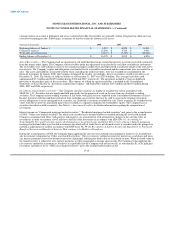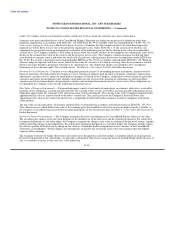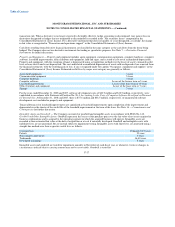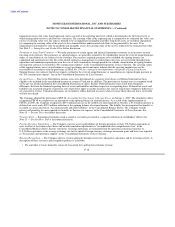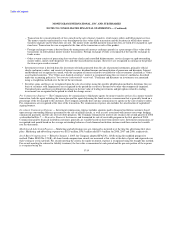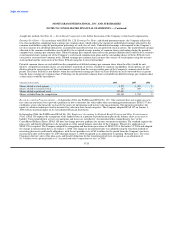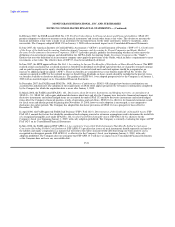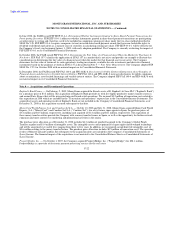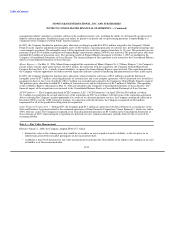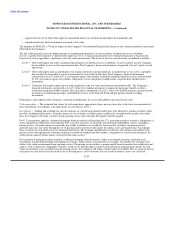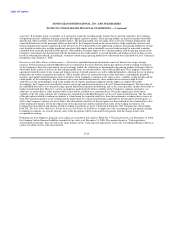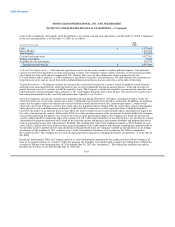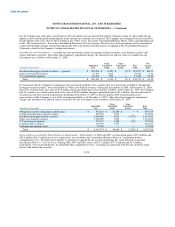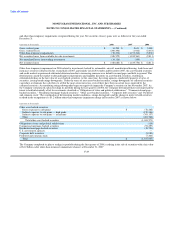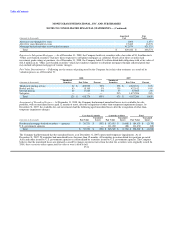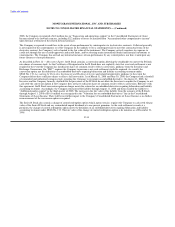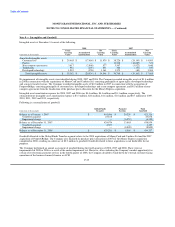MoneyGram 2008 Annual Report Download - page 111
Download and view the complete annual report
Please find page 111 of the 2008 MoneyGram annual report below. You can navigate through the pages in the report by either clicking on the pages listed below, or by using the keyword search tool below to find specific information within the annual report.
Table of Contents
MONEYGRAM INTERNATIONAL, INC. AND SUBSIDIARIES
NOTES TO CONSOLIDATED FINANCIAL STATEMENTS — (Continued)
as Level 3. If no broker quote is available, or if such quote cannot be corroborated by market data or internal valuations, the Company
will perform internal valuations utilizing externally developed cash flow models. These pricing models are based on market observable
spreads and, when available, observable market indices. The pricing models also use inputs such as the rate of future prepayments and
expected default rates on the principal, which are derived by the Company based on the characteristics of the underlying structure and
historical prepayment speeds experienced at the interest rate levels projected for the underlying collateral. The pricing models for certain
asset-backed securities also include significant non-observable inputs such as internally assessed credit ratings for non-rated securities
combined with externally provided credit spreads. Observability of market inputs to the valuation models used for pricing certain of the
Company's investments has deteriorated with the disruption to the credit markets as overall liquidity and trading activity in these sectors
has been substantially reduced. Accordingly, securities valued using a pricing model have consistently been classified as Level 3 financial
instruments since January 1, 2008.
Derivatives and Other Financial Instruments — Derivatives and other financial instruments consist of interest rate swaps, foreign
currency forward contracts and embedded derivatives contained in the Series B Stock and the put options related to trading investments.
As the Company's derivative agreements are not exchange traded, the valuations are determined using pricing models with inputs that are
observable in the market or that can be derived principally from, or corroborated by, observable market data. The Company's derivative
agreements related to interest rate swaps and foreign currency forward contracts are well-established products, allowing the use of pricing
models that are widely accepted in the industry. These models reflect the contractual terms of the derivatives, including the period to
maturity, and market-based parameters such as the price of the Company's common stock, interest rates, volatility, credit spreads and the
credit quality of the counterparty. For the interest rate swaps and forward contracts, these models do not contain a high level of
subjectivity as the methodologies used in the models do not require significant judgment and the inputs are readily observable.
Accordingly, the Company has classified its interest rate swaps and forward contracts as Level 2 financial instruments. The fair value of
the embedded derivatives are estimated using a partial differential equation methodology and, to the extent possible, market observable or
market corroborated data. However, certain assumptions, particularly the future volatility of the Company's common stock price, are
subjective as market data is either unobservable or may not be available on a consistent basis. Given the significance of the future
volatility to the fair value estimate, the Company has classified its embedded derivatives as Level 3 financial instruments. The fair value
of the put options related to trading investments is valued using the expected cash flows from the instruments assuming their exercise in
June 2010 and discounted at a rate corroborated by market data for a financial institution comparable to the put option counter-party, as
well as the Company's interest rate on its Notes. The discounted cash flows of the put option are then reduced by the estimated fair value
of the trading investments. Given the subjectivity of the discount rate and the estimated fair value of the trading investments, the
Company has classified its put options related to trading investments as Level 3 financial instruments. The Company has elected under
FAS 159, The Fair Value Option for Financial Assets and Financial Liabilities, to apply fair value accounting to its put options relating
to trading investments. As a result, the fair value of the put options will be remeasured each period, with the change in fair value
recognized in earnings.
Following are the Company's financial assets which are recorded at fair value by SFAS No. 157 hierarchy level as of December 31, 2008;
the Company had no financial liabilities recorded at fair value as of December 31, 2008. The amount shown as "Cash equivalents
(substantially restricted)" does not reflect the entire balance in the "Cash and cash equivalents" line in the Consolidated Balance Sheets as
cash is not subject to fair value measurement.
F-25


